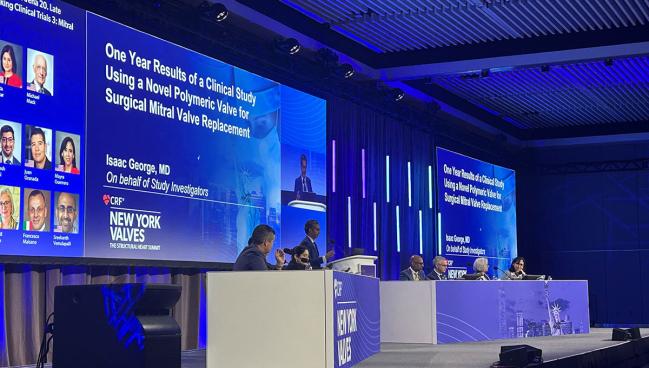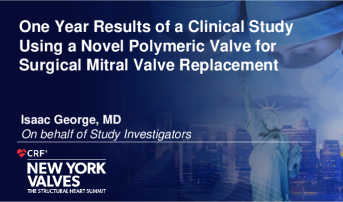Solid, Early Surgical Results With Polymer Mitral Valve
A true test of durability will take many more years, but if the valve holds up, it’s “potentially a game changer,” say surgeons.

NEW YORK, NY—A novel, robotically-made polymer surgical valve has an “acceptable safety” profile and stable hemodynamics through 1 year of follow-up in younger patients with symptomatic mitral valve disease, according to a single-arm study conducted in India.
Treated patients also saw gains in functional outcomes and health status after mitral valve replacement with the Tria valve (Foldax), Isaac George, MD (NewYork-Presbyterian/Columbia University Irving Medical Center, New York, NY), reported last week at New York Valves 2025.
There were five thromboembolic events—three ischemic strokes and two cases of valve thrombosis—observed over 12 months, but George noted that the situation was complicated by issues faced running the study in a developing country, including a high prevalence of rheumatic disease and suboptimal anticoagulation, which was mandated for 12 months after surgery.
The promise of valves made from synthetic polymers is that they will last as long as mechanical valves without breaking down—and have superior durability compared with bioprostheses—but will not require lifelong anticoagulation, which presents particular challenges for women of childbearing age.
Such a device “is the holy grail of valve replacement, whether it’s done surgically or by a transcatheter approach,” Michael Mack, MD (Baylor Scott & White The Heart Hospital – Plano, TX), one of the moderators of the session, commented to TCTMD. “That’s the promise. The question is how you get there from here.”
The only way to know whether any valve will hold up over time is to follow patients for several years, he said, noting that the Tria valve has been implanted in the aortic position in some patients who are off anticoagulation and followed for about 4 years. “It’s only a few patients, but it’s a glimpse. You’re not going to know durability until you get 5 or 10 years out.”
George acknowledged as much during a panel discussion following his presentation. “The value proposition for this is in younger patients, so we need to be able to get 10-, 15-, 20-year data ideally,” he said. “This will be a long journey.”
The Tria Mitral Valve
The Tria valve is primarily made from a siloxane polyurethane that is biocompatible and designed to resist calcification. It has an implantable-grade polyether-ether-ketone radiopaque frame and a polytetrafluoroethylene sewing ring. The three polymer leaflets are dip-cast onto the frame as a single piece. A robot can produce a single valve in about 24 hours.
The single-arm study, conducted across eight centers in India, included 67 patients (mean age 42 years; 64% women) who underwent surgical mitral valve replacement for symptomatic, moderate-to-severe or severe mitral valve disease (mostly mixed mitral regurgitation [MR] and stenosis) and who had no contraindication to anticoagulation. The mean STS risk score at baseline was 1.4%. Nearly three-quarters of patients had rheumatic heart disease and 42% had atrial fibrillation (AF), although only 19% were on chronic anticoagulation. More than half (54%) had NYHA class III/IV heart failure symptoms.
The surgical procedure involved a complete sternotomy and concomitant left atrial appendage closure in all cases, with a mean procedural time of 205 minutes. Patients were started on a vitamin K antagonist with a target INR of 2.0-3.0 and aspirin 75 mg, with anticoagulation planned for 12 months.
George presented the 30-day results of the study last year at New York Valves 2024 and provided the 1-year update at this year’s meeting. The results were published simultaneously online in JACC.
Through 1 year, there were six deaths (9.1%). One occurred during the initial procedure due to surgical complications and the other five after 30 days, but none were related to the valve. Echocardiography at the time of death showed normal valve function for all but one of the patients who died after 30 days.
You’re not going to know durability until you get 5 or 10 years out. Michael Mack
There were no valve reinterventions or cases of structural valve deterioration or endocarditis, with one patient having a moderate paravalvular leak observed within the first 30 days.
One ischemic stroke occurred within 30 days, with two more ischemic strokes and two cases of valve thrombosis recorded beyond that time point. At 1 year, the rate of ischemic stroke was 4.9% and the rate of valve thrombosis was 4.3%. All strokes were nondisabling.
In the first 30 days, there was one major bleed (related to the intraoperative death) and one case of new or worsening heart failure. From 30 days to 1 year, one patient received a new diagnosis of AF. No patients developed hemolysis or kidney failure or required a new pacemaker implant during the study.
Improvements in effective orifice area (EOA) and mean gradient observed at 30 days were sustained out to 1 year, with a mean EOA of 1.5 cm2 and a mean gradient of 4.5 mm Hg at that time point. “These are consistent and favorable comparative to commercial mitral valves on the market,” George said.
There was very little residual MR, with 98.2% of patients having grade ≤ 1 and 1.8% (one patient) grade 2. By 1 year, 81.4% of patients were in NYHA class I and 18.6% were in class II. The 6-minute walk distance increased from 298.1 to 494.8 m and the Kansas City Cardiomyopathy Questionnaire overall score increased from 57.5 to 81.9 points.
A Different Type of Valve
In terms of classifying the polymer valve in relation to others on the market, George said this is neither a mechanical nor tissue valve but a new device altogether.
“We’re going to be learning and evolving together as a community to understand what polymer valves will provide the community [and] what their value potential is,” he said. “I think this is important for us as surgeons, as interventionalists, as echocardiographers to know that polymer valves behave differently than tissue valves.”
There will be a transition period as the field learns about Tria and other polymer valves, he said.
How to handle anticoagulation is an important issue and one that needs to be worked out in a scientifically rigorous way, George pointed out. But “we think the safest way to do this right now for polymer [valves] is to anticoagulate patients,” he said. “We have the precedent with aortic mechanical valves to stepwise reduce [anticoagulation] in a safe fashion, and that’s what we plan to do in upcoming studies in the United States, as well as overseas.”
For now, the Tria valve is commercially available in India and there will be a postmarketing study, George said, adding that anticoagulation-reduction protocols will likely come along with that.
An investigational device exemption (IDE) trial in the United States will hopefully start next year, Mack told TCTMD, adding that the study will include initial anticoagulation followed by a stepwise decrease. It will take 2 to 3 years to get answers about the safety of such an approach, but in the meantime, the field can look to India for information about the Tria valve’s performance, he said.
“There’s tens of thousands of patients in India with rheumatic heart disease that don’t have a good alternative, so I think we’re going to see a very rapid growth of experience in India that will also begin to answer some of these questions,” Mack continued.
Putting the results into a broader context, he pointed out that “this is the first novel technology in surgical valves in the last 50 years, so it truly is potentially a game changer.”
A key advantage for the Tria valve is that it’s very inexpensive to manufacture since it can be done with robots. “So now you have an economically feasible alternative for third-world countries where rheumatic heart disease is so prevalent,” said Mack. “This is something that truly is going to be global because it will be able to be affordable in most countries in the world, and especially in rheumatic heart disease and in childbearing women, who can’t take anticoagulation. So that’s the real potential upside promise here.”
Todd Neale is the Associate News Editor for TCTMD and a Senior Medical Journalist. He got his start in journalism at …
Read Full BioSources
George I, Rao DP, Jain A, et al. One-year results from a multi-center trial of a polymer surgical mitral valve: insights into new technology. JACC. 2025;Epub ahead of print.
Disclosures
- The study was funded by Foldax.
- George reports receiving grant support from Medtronic, Boston Scientific, Edwards Lifesciences; receiving consulting honoraria from Zimmer Biomet, Atricure, Neosurgery, Neptune Medical, Abbvie, Johnson & Johnson, Durvena, Boston Scientific, Edwards Lifesciences, Medtronic, Encompass Medical, Summus Medical, Abbott SJM, BCI, Xeltis, Innocardiac, and KIS Medical; serving on advisory boards for Edwards Surgical, Medtronic Surgical, Medtronic Structural Mitral & Tricuspid, Trisol Medical, Valcare Medical, Durvena, Abbvie, Johnson & Johnson, Foldax Medical, Zimmer Biomet, Neosurgery, Abbvie, Boston Scientific, Summus Medical, BCI, Encompass Medical, HVT Medical, Innocardiac, and KIS Medical; having equity in Valcare Medical, Durvena, CardioMech, VDyne, MitreMedical, BCI, Trisol Medical, HVT Medical, Foldax, and KIS Medical; and receiving institutional funding to Columbia University from Edwards Lifesciences, Medtronic, Abbott Vascular, Boston Scientific, and JenaValve.






Comments